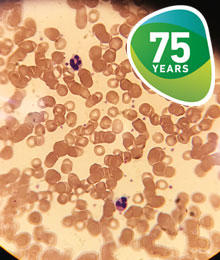Restriction enzymes and the process of genetic modification

Microbiology is a pioneering discipline. Many of the fundamental processes of biology were first elucidated in microbial systems – deciphering the genetic code, the one gene–one enzyme hypothesis, the mRNA hypothesis, the first genome sequences, and many more key biological breakthroughs were all the result of microbiologists. Over sixty years ago, the first genetic switches to be characterised were in bacteria, and we continue to learn about bacterial gene regulation mechanisms and about genome-wide, collective control of gene expression.
Restriction enzymes
In 1978, a swiss microbiologist named Werner Arber received the Nobel Prize in Physiology or Medicine for his discovery of restriction enzymes. Restriction enzymes are tools for monitoring Restriction Fragment Length Polymorphisms. They allow the location of mutations, generation of human linkage maps, identification of disease genes (such as sickle cell trait or Huntington’s disease), and DNA fingerprinting.
Over the years, research into restriction enzymes has progressed and today scientists have categorised them into three types: type I, which recognise specific DNA sequences, but make their cut at seemingly random sites that can be as far as 1,000 base pairs away from the recognition site; type II, which recognize and cut directly within the recognition site; and type III, which recognize specific sequences but make their cut at a different specific location that is usually within about 25 base pairs of the recognition site.
Why does understanding restriction enzymes and genetic modification matter to microbiology?
Modern biotechnology is founded on microbial systems. Combining microbial genetics with single-molecule and single-cell techniques, together with advances in imaging such as super resolution microscopy, is providing understanding of molecular processes at unprecedented levels of detail. Research into the field of restriction enzymes, has allowed molecular biologists to utilise powerful tools to create nearly limitless combinations of recombinant DNA.
Read more about why studying restriction enzymes and the process of genetic modification matters to our members and the wider microbiology community, access our additional resources.
-
Microbiologists working in this area
To celebrate our 75th anniversary in 2020, we invited microbiologists to nominate the discovery or event that best showcases why microbiology matters and helps us demonstrate the impact of microbiologists past, present and future. Learn more about the microbiologists who are studying restriction enzymes and the process of genetic modification.
-
Resources and further reading
Explore how scientists are diagnosing and sequencing Ebola in Sierra Leone, how next-generation sequencing technologies are enabling us to study our world like never before, and genome editing and the cultural imagination.
-
Revisit our digital collections showcasing why microbiology matters
Over the past year, we have launched seven new digital collections of content to summarise why our membership thinks microbiology matters. Visit our previous hubs to learn more about the fascinating world of microbiology.





